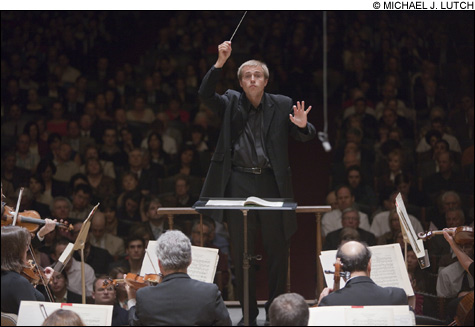Guerilla Opera, von Stade’s farewell, the BSO, Handel and Haydn, the BPO, and that Tosca
By LLOYD SCHWARTZ | October 14, 2009

THE BALLETIC FLEXIBILITY OF NUREYEV? Yes, and that was just part of the appeal of BSO substitute guest conductor Vasily Petrenko. |
My head’s swimming. I’ve been to so many performances lately, in my previous review I got Discovery Ensemble horn player Kevin Owen mixed up with BSO cellist Owen Young. My apology — there’s also a poet I like named Kevin Young. I hope I don’t get Frederica von Stade confused with Sarah Palin.
Yes, Sarah Palin! Guerilla Opera, which specializes in new work, got a lot of press for Curtis K. Hughes’s Say It Ain’t So, Joe, a 90-minute opera based on — even transcribing — the not exactly scintillating 2008 vice-presidential debate. Hughes calls it “a light tragedy,” and it attracted enough people to Boston Conservatory’s tiny Zack Box Theater to warrant an extra performance. I liked the Hughes piece that opened last year’s Ditson Festival. But I found Joe torture. The music — for clarinets, saxes, cello, and percussion, performed by four skillful players — seemed characterless. Nathan Troup’s stage direction was amateurish and heavy-handed, with closed-circuit live camerawork (the latest cliché in staging) just getting in the way. And the singing was uneven. Some plausible ideas — the vocal line mimicking speech inflections; using two singers for Sarah — didn’t work because the music didn’t work. Nothing did.
On a happier note: the Celebrity Series of Boston opened its new season with a farewell concert by the endearing, un-diva-like mezzo-soprano Frederica von Stade, with her special guest, soprano Kiri Te Kanawa (who made her own farewell last season). They’ve been friends since Dame Kiri’s American debut at the Santa Fe Opera in 1971, when she sang the Countess opposite von Stade’s Cherubino in Mozart’s Le nozze di Figaro. I was a Santa Fe Opera volunteer that summer, and I’ll never forget the jaw-dropping creaminess of Te Kanawa’s voice and the subtlety of von Stade’s characterization. Instead of being embarrassed to disguise himself as a girl, her Cherubino was so eager to get under a girl’s skirt, he got a charge out of wearing one.
They opened their packed Symphony Hall concert singing the comic-insult duet between Susanna (Figaro’s bride) and Marcellina (Figaro’s mother) — roles they didn’t play at Santa Fe — and closed the first half with Mozart’s Fiordiligi and Dorabella comparing fiancées in Cosí fan tutte. Te Kanawa’s voice has thinned considerably, yet her Zauberflöte aria showed her familiar vocal whipped cream. But for character and stylistic point, there was only von Stade. (I’m still haunted by her “O Waly, Waly.”) Te Kanawa’s best moment was in the famous “Rossini” duet for two cats; it was the first time I’ve ever heard her sacrifice beauty of tone for dramatic effect. Her meowing was more genuinely feline — and even funnier — than von Stade’s.
The two stars were having a great time in what was more a sentimental than an artistic occasion — though neither von Stade’s artistry nor accompanist Brian Zeger’s was ever out of sight. She delivered her closing encore, “La vie en rose,” with tenderness, tonal warmth, and the bittersweet subtext that a career was coming to an end. A career for which she — like the rest of us — was infinitely grateful.
 Topics
Topics:
Classical
, Entertainment, Music, Seiji Ozawa, More  , Entertainment, Music, Seiji Ozawa, Seiji Ozawa, Rudolf Nureyev, Rudolf Nureyev, Ann Hobson, Claude Debussy, Peter Sellars, Harry Christophers, Less
, Entertainment, Music, Seiji Ozawa, Seiji Ozawa, Rudolf Nureyev, Rudolf Nureyev, Ann Hobson, Claude Debussy, Peter Sellars, Harry Christophers, Less 